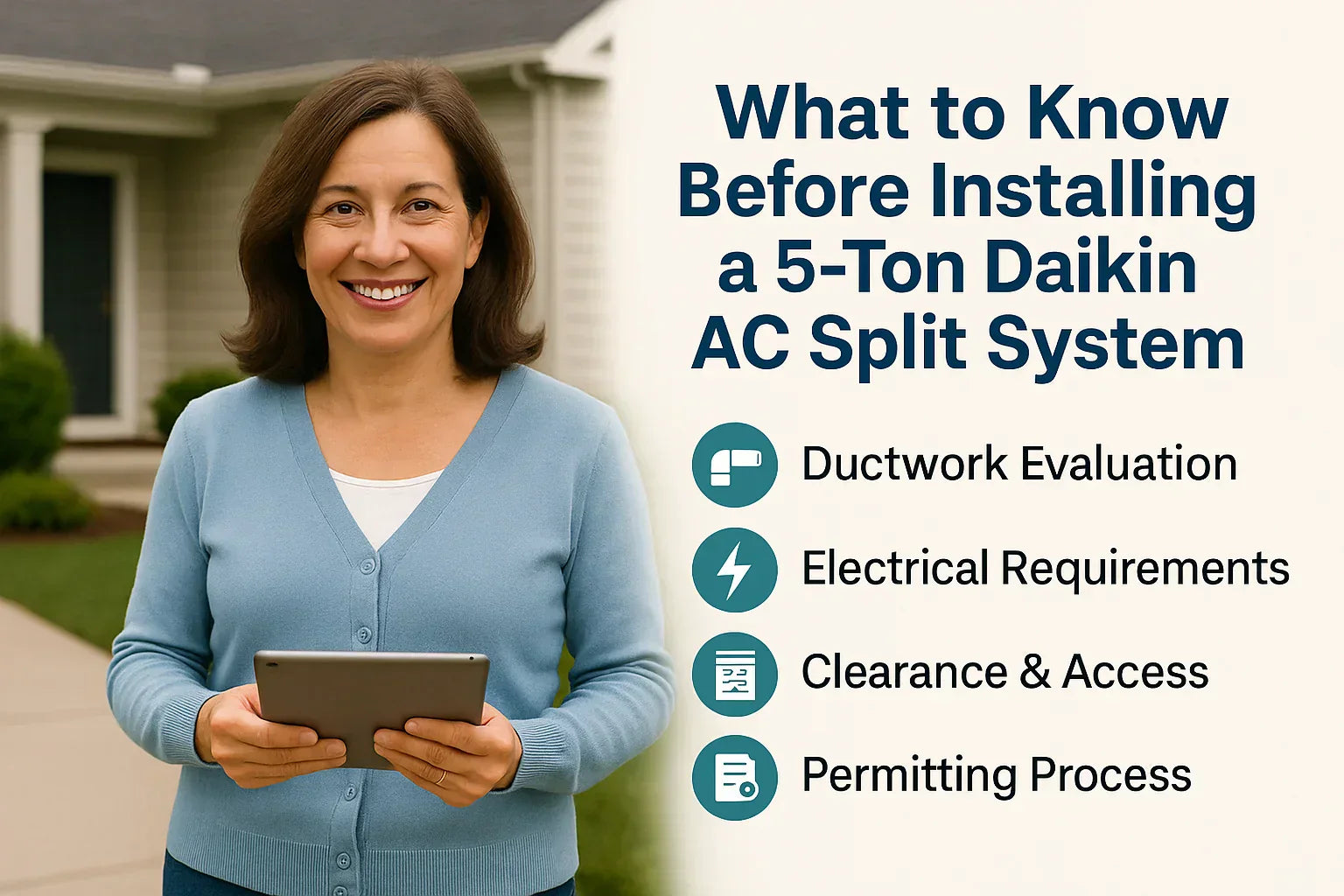Installing a Daikin Light Commercial 5-Ton 13.4 SEER2 Split System is a significant investment for your business or large home, and proper planning ensures your system performs efficiently for years to come.
This guide will walk you through:
-
Pre-purchase and pre-installation planning.
-
Mechanical, electrical, and ductwork requirements.
-
Space and clearance considerations.
-
Permits, code compliance, and inspection needs.
-
Budgeting for installation costs.
-
Choosing a qualified HVAC installer.
📋 Pre-Installation Checklist
Before committing to your 5-ton Daikin AC system:
✅ Verify system capacity: Use a Manual J load calculation to confirm a 5-ton system fits your building needs. Learn about Manual J here.
✅ Inspect your electrical panel: A 5-ton system requires a dedicated 208/230V circuit. Confirm your panel has capacity or plan for upgrades.
✅ Evaluate ductwork: Older or undersized ducts can reduce efficiency and airflow. Have your contractor assess for leaks, sizing, and airflow balancing.
✅ Plan space requirements: Check the indoor air handler and outdoor unit dimensions for clearances in your mechanical room or rooftop.
✅ Understand local permits and code requirements: Contact your local building department or HVAC contractor for necessary permits and inspections.
✅ Request multiple quotes: Compare bids from licensed HVAC professionals to align cost with your expectations.
🏗️ Space and Clearance Requirements
Indoor Air Handler:
-
Confirm mechanical room access.
-
Maintain clearance around the unit for service and airflow (typically 24-30 inches recommended).
-
Plan for a drain line and adequate slope for condensate removal.
Outdoor Condenser:
-
Place on a level pad or rooftop curb.
-
Maintain 12-24 inches clearance on all sides.
-
Ensure clear airflow and avoid obstructions (bushes, walls).
-
Check local noise ordinances if placing near occupied areas.
For detailed mechanical clearance guidelines, see Energy Saver's AC installation planning.
⚡ Electrical Requirements
A 5-ton system typically requires:
-
A dedicated 208/230V circuit.
-
Proper breaker sizing (typically 40-60 amps depending on model).
-
Correct wire gauge for the distance from the panel.
-
A weatherproof disconnect box near the outdoor unit.
A licensed electrician should handle these requirements to ensure safety and code compliance.
Learn more about safe HVAC electrical connections with This Old House.
🪄 Ductwork Considerations
Efficient performance depends on ductwork that: ✅ Supports adequate airflow for 5-ton capacity (~2,000 CFM). ✅ Is properly sealed and insulated. ✅ Includes sufficient return air pathways. ✅ Can handle zoning if your building requires it.
Your HVAC contractor should inspect for:
-
Leaks using duct blaster tests.
-
Undersized supply and return trunks.
-
Potential for adding additional returns to improve performance.
Reference Energy Star's guide on duct sealing to understand how ducts affect AC efficiency.
🏠 Rooftop vs. Ground Installation
Rooftop Installation:
✅ Frees up ground space. ✅ Requires structural verification for weight support. ✅ Needs safe service access for technicians. ✅ May require a crane for placement.
Ground Installation:
✅ Easier to service. ✅ Requires a clear, level pad with drainage considerations. ✅ Needs protection from debris, vegetation, and tampering.
Consult your contractor to determine the best installation location based on your site and maintenance access needs.
🪪 Permits, Codes, and Inspections
Before installation, check:
-
Local building permits and fees.
-
Mechanical and electrical codes specific to your city/state.
-
Required inspections post-installation for code sign-off.
Your HVAC contractor typically handles permits, but you should verify what is included in their quote.
Find local building code resources at the International Code Council.
💸 Installation Costs: What to Expect
Equipment Cost:
$3,800–$5,000 for the Daikin 5-ton AC split system.
Installation Cost:
$4,000–$8,000 depending on:
-
Ductwork updates or replacements.
-
Electrical upgrades.
-
Crane service for rooftop installs.
-
Permit and inspection fees.
-
Regional labor rates.
Total Budget:
Expect $7,800–$13,000 for a turnkey installation.
For budgeting guidance, see Energy Star's HVAC cost considerations.
👷 Choosing a Qualified Installer
✅ Look for licensed and insured HVAC contractors. ✅ Verify experience with 5-ton light commercial or large residential systems. ✅ Request references from similar projects. ✅ Confirm warranty and post-installation service support. ✅ Get a clear, detailed quote outlining scope, parts, and labor.
Your installer is critical to the system's performance, lifespan, and efficiency.
🎯 Key Takeaways
✅ Confirm your property’s cooling needs with a load calculation. ✅ Plan for space, electrical, and ductwork needs. ✅ Budget for total installation costs, not just equipment. ✅ Secure permits and plan for inspections. ✅ Choose a qualified contractor for peace of mind.
Ready to plan your installation? Reach out to The Furnace Outlet team or your licensed HVAC professional today for a customized consultation.
In the next topic we will know more about: 13.4 SEER2: What It Means for Your Cooling Costs







